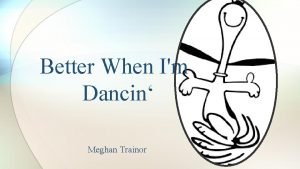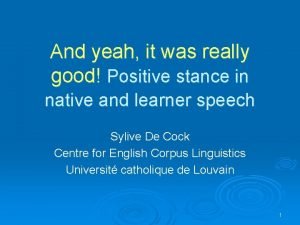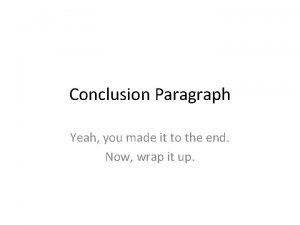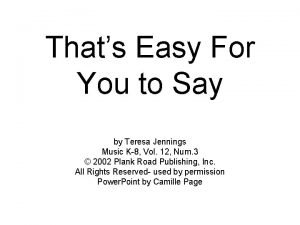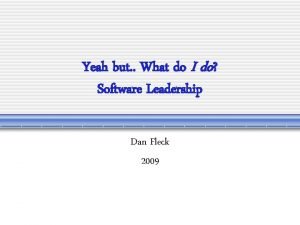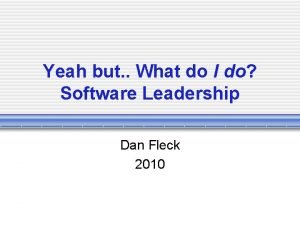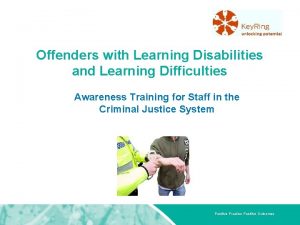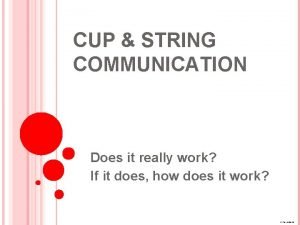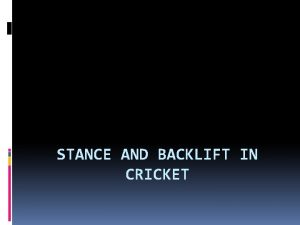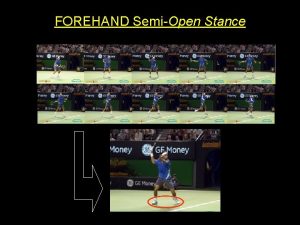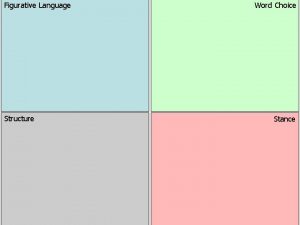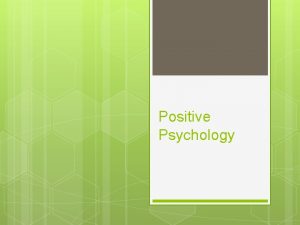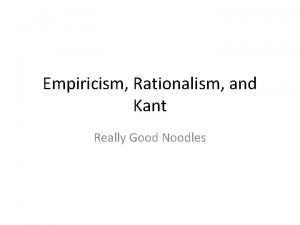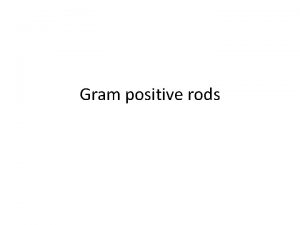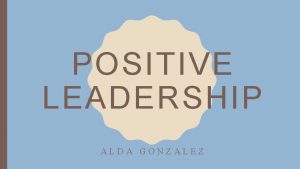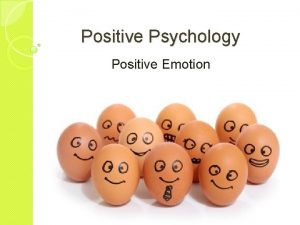And yeah it was really good Positive stance




















- Slides: 20

And yeah, it was really good! Positive stance in native and learner speech Sylive De Cock Centre for English Corpus Linguistics Université catholique de Louvain 1

Introduction Ø Attitudinal stance (Biber et al. 1999, Conrad and Biber 2000) l l conveys speakers’ personal attitudes or feelings e. g. likes and dislikes, evaluations of events and personal experiences LINDSEI and LOCNEC particularly good to study this sort of phenomenon (informal interviews, topics) – see De Cock 2007 (LIKE, LOVE, ENJOY) Ø Work in progress Ø Focus on Ø l l positive attitudinal stance adjectives 2

Data and method Ø LOCNEC and LINDSEI_French Ø Starting point: word lists (Word. Smith Tools) – Compare list Ø Selection of the adjectives l Biber et al. (1999)’s semantic group of descriptors (vs classifiers) evaluative/emotive subcategory (i. e. denoting judgement, affect, emphasis: bad, beautiful, good, great, lovely, nice, etc. ) 3

Data and method Ø Focus on l l l Positive evaluative adjectives Prototypical (good; big? ) Frequent in LOCNEC and/or LINDSEI_FR 4

Positive evaluative adjectives Ø LOCNEC l l l l good (345) nice (191) interesting (61) great (54) better (47) beautiful (44) pretty (41) brilliant (38) amazing (36) impressive ( 31) lovely (19) important (14) wonderful (14) Ø LINDSEI l l l l good (110) beautiful (103) interesting (92) nice (79) great (62) better (37) important (25) wonderful (25) pretty (23) lovely (18) impressive (17) amazing (13) incredible (13) 5

Data and method Ø Focus on l l l Positive evaluative adjectives Prototypical (good; big? ) Frequent in LOCNEC and/or LINDSEI_FR ‘General’ positive evaluative adjectives (good/pleasant/enjoyable) Picture story effect (beautiful, pretty) Disambiguation (adverbs, nouns, etc. ) 6

(General) Positive evaluative adjectives Ø LOCNEC l l l good nice great better brilliant amazing impressive lovely wonderful fantastic incredible Ø LINDSEI_FR l l l l l good nice great better wonderful lovely impressive amazing incredible 7

Positive evaluative adjectives Ø Selected findings l l l syntactic patterns collocations idiosyncratic uses 8

Frequency and range Ø Frequency counts: overall lower in NNS l l Ø good (NS: 293; NNS: 118) nice (NS: 172; NNS: 93) amazing (NS: 30; NNS: 14) BUT wonderful (NS: 12; NNS: 27) Range: overall more limited stock of recurrent positive evaluative adjectives in LINDSEI_FR (e. g. brilliant, attractive, enjoyable) 9

Syntactic patterns Attributive and predicative use Ø = nice (NS: 27% and 73%; NNS: 25% and 75%) Ø ≠ good (NS: 42% and 58%; NNS: 52% and 48%) Ø Recurrent sequences: NS only Ø l l it’s good, it was good, (and / yeah) it was really good it was quite good, that was good, it’s really good 10

Syntactic patterns <B> it was a very good experience for me. yes because they. made a lot of critics (NNS) Ø it was just really good I really liked it (NS) Ø. . wrote a script for a play at college. and I got to see that acted out and it was really good (NS) Ø <B> is it a part two course or <B> <A> erm I think so but I’m not sure I think it is <A> <B> oh right er. . I might have to look into that sounds really good <B> (NS) Ø 11

Syntactic patterns Ø Adjective complementation Ø BE nice to + inf. … Ø NS: 21 (16% of predicative uses); NNS: 3 (4% of predicative uses) Ø it’d be nice to go somewhere different (NS) Ø but erm. yeah it’s nice to see her when I do see her (NS) 12

Syntactic patterns Evaluative adjectives in evaluative relative clauses (which = a collocate + recurrent sequences: which is good, which was, which is quite, which is a bit, which is very) Ø NS > NNS Ø I’ve got other people to hitch with which is good (NS) Ø but the next year we went I took some books and I was giving them to people which was really nice (NS) Ø 13

Syntactic patterns <B> they all come and visit me cos they think it’s great having a student life so close to <X> so a lot of them travel up at weekends and that [ which is quite nice <B> (NS) Ø Tao and Mc. Carthy (2001 – spoken NS English): sentential relative clauses tend to have evaluative function displaying speakers’ affective involvement with and attitudes to the events and experiences they are relating Ø 14

Collocations ? ? ? Ø good fun Ø Claire was good fun; it’s good fun (NS) Ø NS 16 vs NNS 1 (!input from the interviewer) Ø <B> no. . it’s. . very pleaseful. . <XX> pleased to <B> <A> oh you mean you like it. you mean good fun <A> <B> yeah good fun yes really <B> (NNS) Ø 15

Collocations Ø Idiosyncratic uses Ø we: we went. . er in a restaurant and er. with the girl and then to the cinema and we had a great fun and the next day (NNS) Ø <B> yes but I think it’s a. very great job you know <B> (NNS) Ø it was very great for them to live that way (NNS) 16

Rounding off Work in progress Ø Positive and negative evaluative adjectives Ø General picture of attitudinal stance Ø Other subcorpora (L 1 -related or not) Ø Assess the ‘picture story effect’ + topic chosen? Ø Individual variation Ø Other effects? : input from the interviewer Ø 17

Rounding off Ø Implications for teaching l l range collocations typical syntactic patterns more prominence given to the description and use of evaluative (sentential) relative clauses in informal speech Ø Attitudinal stance in textbooks? 18

Thank you for your attention! 19

References Ø Ø Biber, D. , Johansson, S. , Leech, G. , Conrad, S. and Finegan, E. 1999. Longman Grammar of Spoken and Written English. London: Longman. Conrad, S. and Biber, D. 2000. "Adverbial marking of stance in speech and writing. " In Evaluation in Text. Authorial Stance and the Construction of Discourse, S. Hunston and G. Thompson (eds). Oxford: Oxford University Press, 56 -73. De Cock, S. 2007. “Routinized building blocks in native speaker and learner speech: Clausal sequences in the spotlight”. In Spoken Corpora in Applied Linguistics, M. C. Campoy and M. J. Luzón (eds). Bern: Peter Lang, 217 -233. Tao, H. and Mc. Carthy, M. J. 2001. Understanding non-restrictive which-clauses in spoken English, which is not an easy thing. Language sciences 23: 651 -677. 20
 I bet you
I bet you War by edwin starr meaning
War by edwin starr meaning Positive stance
Positive stance Final thoughts examples
Final thoughts examples Yeah that's easy for you to say
Yeah that's easy for you to say Yeah host
Yeah host Yeah but i do
Yeah but i do Yeah but i do
Yeah but i do Hare rama
Hare rama Past tense of practicar
Past tense of practicar Yeah diagram
Yeah diagram Good thoughts good words good deeds
Good thoughts good words good deeds When is afternoon and evening
When is afternoon and evening Good afternon animado
Good afternon animado You are good you are good when theres nothing good in me
You are good you are good when theres nothing good in me Good afternoon students
Good afternoon students All staphylococci are catalase positive
All staphylococci are catalase positive What's 8 + 5
What's 8 + 5 Positive practice positive outcomes
Positive practice positive outcomes Basic human aspirations is
Basic human aspirations is Does the cup and string work
Does the cup and string work
